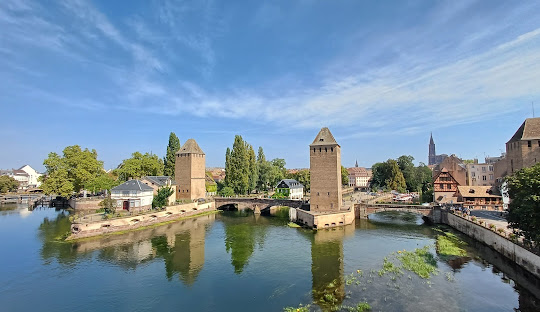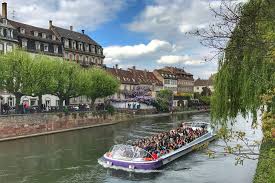Travelling to Strasbourg

Discovering Strasbourg: A Cultural Gem of Europe
Strasbourg, located in the Alsace region of France, is a city renowned for its rich history, stunning architecture, and vibrant multicultural atmosphere. As the seat of the European Parliament and a city that straddles the border of France and Germany, Strasbourg offers visitors a unique blend of both cultures, making it a must-visit destination in Europe. With its picturesque canals, charming half-timbered houses, and a wealth of cultural attractions, Strasbourg is a city that captivates the heart and soul of every traveler.
This comprehensive guide will take you through the enchanting city of Strasbourg, covering its history, iconic landmarks, culinary delights, local culture, and practical travel tips for a memorable visit.
A Brief History of Strasbourg
1. Ancient Origins: A Roman Settlement
Strasbourg’s history dates back to Roman times when it was known as Argentoratum. The strategic location along the Rhine River made it an important trading post for the Romans.
- Roman Influence: The Romans built a fortified settlement here, and remnants of their influence can still be seen in the city’s infrastructure and archaeological sites.
2. Medieval Era: A Growing City
In the Middle Ages, Strasbourg grew in importance as a center of commerce and culture. It became a free city within the Holy Roman Empire, gaining autonomy and establishing its own laws and governance.
- Religious Significance: The construction of Strasbourg Cathedral, a masterpiece of Gothic architecture, began during this period and became a symbol of the city’s power and influence.
3. Renaissance and Beyond: A Cultural Melting Pot
The 16th century brought significant changes to Strasbourg, including the influence of the Protestant Reformation. The city became a center for intellectual and artistic developments.
- French and German Influence: Over the centuries, Strasbourg switched hands between France and Germany, resulting in a unique blend of cultures that is evident in its architecture, language, and cuisine.
Iconic Landmarks of Strasbourg
Strasbourg is home to numerous landmarks that reflect its rich history and architectural beauty. Here are some of the must-visit attractions in the city.
1. Strasbourg Cathedral (Cathédrale Notre-Dame de Strasbourg)
The Strasbourg Cathedral is one of the most remarkable Gothic cathedrals in Europe. Its intricate facade and stunning spire make it a defining feature of the city’s skyline.
- Architectural Marvel: Construction of the cathedral began in the 12th century and continued for several hundred years. The cathedral is famous for its stunning stained glass windows, intricate carvings, and the astronomical clock.
- Panoramic Views: Visitors can climb the 332 steps to the top of the cathedral’s spire for breathtaking views of the city and surrounding countryside.
2. La Petite France: A Picturesque Neighborhood
La Petite France is a charming historic district characterized by its half-timbered houses, narrow canals, and cobblestone streets. This area is a UNESCO World Heritage site and is often considered the most picturesque part of Strasbourg.
- Canal Walks: Stroll along the canals and admire the beautiful architecture. The area is filled with cozy cafés, shops, and restaurants, making it a perfect spot to relax and soak in the ambiance.
- Historical Significance: Once home to tanners and fishermen, La Petite France showcases the city’s rich history and is a great place to learn about traditional Alsatian crafts.
3. Palais Rohan: A Glimpse into Royal History
The Palais Rohan is a stunning baroque palace that houses three museums: the Museum of Fine Arts, the Museum of Decorative Arts, and the Archaeological Museum.
- Art and Culture: Visitors can explore a diverse collection of art and artifacts, ranging from medieval to modern times. The palace itself is a work of art, with opulent rooms and beautiful gardens.
- Guided Tours: Guided tours are available, providing insight into the history of the palace and its significance to the city.
4. European Institutions: A Center for Diplomacy
Strasbourg is known as the political capital of Europe, home to several key institutions, including the European Parliament and the Council of Europe.
- European Parliament: Visitors can take guided tours of the European Parliament building, learning about its role in European governance and politics.
- Parc de l’Atlas: The surrounding park offers a peaceful escape from the bustling city, with beautiful gardens and walking paths.
5. Palais de l’Opéra: A Cultural Landmark
The Palais de l’Opéra is an elegant opera house that hosts a variety of performances, including opera, ballet, and concerts. Its stunning architecture and rich cultural offerings make it a highlight for visitors.
- Performance Schedule: Check the schedule for upcoming performances, as attending a show at the opera house is a memorable experience.
- Guided Tours: Guided tours of the opera house are also available, allowing visitors to explore its beautiful interiors and learn about its history.
Culinary Delights: The Flavors of Strasbourg
Strasbourg’s culinary scene reflects its unique blend of French and German influences. The city is known for its rich flavors, hearty dishes, and fine wines, making it a paradise for food lovers.
1. Local Specialties: A Taste of Alsace
Strasbourg is home to a variety of traditional dishes that showcase the flavors of the Alsace region.
- Choucroute Garnie: This hearty dish consists of sauerkraut served with various meats, such as sausages and smoked pork. It is a staple of Alsatian cuisine and is often accompanied by potatoes.
- Tarte Flambée (Flammekueche): Similar to pizza, this thin crust dish is topped with crème fraîche, onions, and bacon. It is a delicious and popular choice among locals.
- Bretzels: Soft pretzels are a beloved snack in Strasbourg. Try them warm, sprinkled with salt, or filled with cheese or other savory ingredients.
2. Wine and Beer: A Toast to the Region

Alsace is famous for its wine production, particularly white wines such as Riesling and Gewürztraminer. Strasbourg is also home to a burgeoning craft beer scene.
- Wine Tastings: Visit local wine cellars and vineyards to sample Alsatian wines. Many establishments offer tastings and tours, allowing you to learn about the winemaking process.
- Local Breweries: Explore Strasbourg’s craft breweries, where you can taste a variety of beers, including traditional Alsatian brews.
3. Dining Options: From Casual Bistros to Fine Dining
Strasbourg offers a diverse range of dining options, catering to every taste and budget.
- Casual Bistros: Enjoy traditional Alsatian dishes in cozy bistros such as La Cloche à Fromage and Le Gruber. These establishments provide a warm and welcoming atmosphere.
- Fine Dining: For a special occasion, consider dining at Michelin-starred restaurants like Au Crocodile and La Meinau. These establishments showcase innovative cuisine and exceptional service.
4. Markets and Food Festivals
Strasbourg’s markets are a food lover’s delight, offering fresh produce, local specialties, and artisanal products.
- Strasbourg Christmas Market: One of the oldest and most famous Christmas markets in Europe, the Strasbourg Christmas Market transforms the city into a winter wonderland. Visitors can enjoy mulled wine, gingerbread, and handmade crafts.
- Food Markets: Explore local markets like Marché de la Gare and Marché Broglie, where you can find fresh produce, cheeses, and cured meats, perfect for a picnic or a taste of local flavors.
Exploring Strasbourg’s Neighborhoods
Strasbourg is a city of diverse neighborhoods, each with its own unique character and charm. Exploring these areas allows visitors to experience the local culture and lifestyle.
1. Neustadt: A Blend of History and Modernity
Neustadt is a district characterized by its Haussmannian architecture and wide boulevards. This area reflects Strasbourg’s growth during the German Empire and is now home to several cultural institutions.
- University of Strasbourg: One of the oldest universities in Europe, the University of Strasbourg adds a vibrant atmosphere to the neighborhood. Visitors can explore its beautiful campus and attend cultural events.
- Modern Art Museum: The Musée d’Art Moderne et Contemporain showcases a diverse collection of modern and contemporary art. The museum often hosts temporary exhibitions and cultural events.
2. Robertsau: A Green Oasis
Robertsau is a residential neighborhood located along the Rhine River, known for its green spaces and parks. It’s an ideal area for those seeking a peaceful retreat from the city’s hustle and bustle.
- Parc de l’Hotel de Ville: This beautiful park features walking paths, playgrounds, and picnic areas. It’s a perfect spot to relax and enjoy nature.
- Rhine River Walks: Take a leisurely walk along the Rhine River, where you can enjoy scenic views and observe local wildlife.
3. Krutenau: A Bohemian Vibe
Krutenau is a lively neighborhood known for its artistic atmosphere, trendy cafés, and nightlife. This area is popular among students and young professionals.
- Cafés and Bars: Krutenau is home to numerous cafés and bars where you can enjoy a drink and soak in the local ambiance. Try Café des Anges for a cozy atmosphere and great coffee.
- Cultural Events: The neighborhood often hosts cultural events, art exhibitions, and live music performances, providing a vibrant social scene.
Cultural Events and Festivals in Strasbourg
Strasbourg is a city that celebrates its cultural diversity through various events and festivals throughout the year. Here are some notable events to consider during your visit.
1. Strasbourg Christmas Market
The Strasbourg Christmas Market is one of the oldest and most famous in Europe. Held annually from late November to December, the market attracts visitors from all over the world.
- Magical Atmosphere: The market transforms the city into a winter wonderland, with beautifully decorated stalls offering handmade crafts, mulled wine, and traditional treats.
- Cultural Activities: Enjoy live music, festive performances, and holiday-themed events throughout the market, creating a magical experience for visitors of all ages.
2. European Heritage Days

Every September, Strasbourg participates in the European Heritage Days, allowing visitors to explore historical sites, museums, and monuments that are typically closed to the public.
- Guided Tours: Take advantage of guided tours and special activities that showcase the city’s rich heritage and cultural significance.
- Cultural Performances: Enjoy live performances, exhibitions, and workshops that celebrate Strasbourg’s diverse cultural landscape.
3. Strasbourg Music Festival
The Strasbourg Music Festival is an annual event that celebrates a variety of music genres, from classical to contemporary. The festival features performances by local and international artists.
- Concert Venues: Enjoy concerts in beautiful venues throughout the city, including the Palais de l’Opéra and outdoor stages in picturesque parks.
- Workshops and Masterclasses: Participate in workshops and masterclasses led by renowned musicians, providing a unique opportunity to learn and engage with the music community.
Practical Tips for Visiting Strasbourg
To ensure a smooth and enjoyable visit to Strasbourg, here are some practical tips to keep in mind.
1. Getting Around Strasbourg
Strasbourg has an efficient public transportation system, making it easy to navigate the city.
- Tram System: The Strasbourg tram network is extensive and convenient, with lines connecting major attractions and neighborhoods. Purchase a day pass for unlimited travel within the city.
- Biking: Strasbourg is a bike-friendly city, with dedicated bike lanes and rental services available. Exploring the city on a bike is a great way to see the sights at your own pace.
2. Best Time to Visit
- Spring and Fall: The best times to visit Strasbourg are during the spring (April to June) and fall (September to October). The weather is mild, and the city is less crowded compared to the summer months.
- Summer: Summer (July to August) is peak tourist season, attracting visitors to its festivals and outdoor events. Be prepared for larger crowds and higher accommodation prices.
3. Language and Communication
- Language: While French is the official language, many locals also speak German and English. Basic knowledge of French phrases can enhance your experience and interactions with locals.
- Cultural Etiquette: Greeting locals with a polite “Bonjour” is customary. French culture values politeness, so taking the time to learn a few phrases can go a long way.
4. Safety and Health
Strasbourg is generally a safe city for travelers. However, it’s always wise to take standard precautions.
- Emergency Numbers: In case of emergencies, dial 112 for medical assistance, 17 for police, and 18 for fire services.
- Health Insurance: Ensure you have travel health insurance to cover any medical expenses during your stay.
Conclusion
Strasbourg is a captivating destination that offers a perfect blend of history, culture, and culinary delights. From the breathtaking beauty of the Strasbourg Cathedral to the charming streets of La Petite France, the city invites visitors to explore its many treasures.
With its rich culinary scene, vibrant neighborhoods, and year-round cultural events, Strasbourg is a city that enchants and inspires. Whether you’re strolling along the canals, savoring local specialties, or immersing yourself in the arts, Strasbourg promises an unforgettable experience at the crossroads of Europe.
So pack your bags and get ready to discover the magic of Strasbourg, where the charm of the past meets the vibrancy of the present, and every corner reveals a new story waiting to be told.

2 Responses
htkhojxgufhzwgkejzjnolroonzyxm
Searching for natural dreads for sale?
Discover the finest natural dreads at natural dreadlocks, your leading store for natural dreadlocks extensions online.
Our collection of natural locs offers premium-quality dreads made from 100% human hair, ensuring a flawless blend for any style. Whether you want long natural dreadlocks or customized naturally dread hair, we have just what you need.
Why choose our natural dreadlock extensions?
– 100% human hair for durability and realism.
– Expertly crafted by skilled artisans to blend seamlessly.
– Available in a wide range of colors, including natural grey dreadlocks.
– Suitable for protective styles
– Fast delivery with tracking and support.
Shop natural dreads that offer comfort and style. Our natural dreadlocks extensions are perfect for adding volume and length without compromising authenticity.
Explore the finest natural dreadlocks collection and take your hairstyle to the next level with realistic natural dreadlocks hair. Whether you are seasoned in natural hair styles, we provide products that celebrate your unique identity.
Order now from Searching for natural dreads for sale?
Discover the finest natural dreads at naturally dread hair, your leading store for buying natural dreadlocks online.
Our collection of natural locs offers handcrafted extensions made from 100% human hair, ensuring authentic texture for any style. Whether you want long natural dreadlocks or customized naturally dread hair, we have the perfect set.
Why choose our natural dreadlock extensions?
– 100% human hair for durability and realism.
– Expertly crafted by skilled artisans to match your natural hair.
– Available in various lengths and shades, including earthy hues.
– Suitable for long-term wear
– Fast US shipping with tracking and support.
Shop natural dreads that offer comfort and style. Our dreads natural are perfect for adding volume and length without compromising authenticity.
Explore the best natural dread products and take your hairstyle to the next level with beautiful natural locs for sale. Whether you are seasoned in natural hair styles, we provide products that celebrate your unique identity.
Order now from — your destination for natural dreadlocks. — where natural dread hair meets artistry.